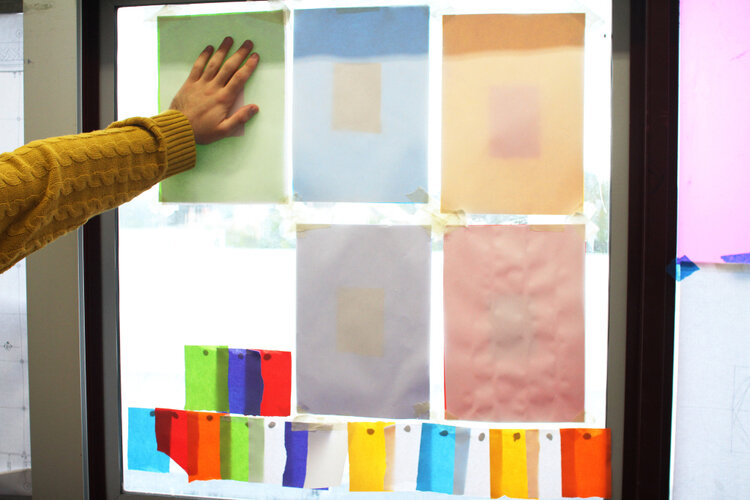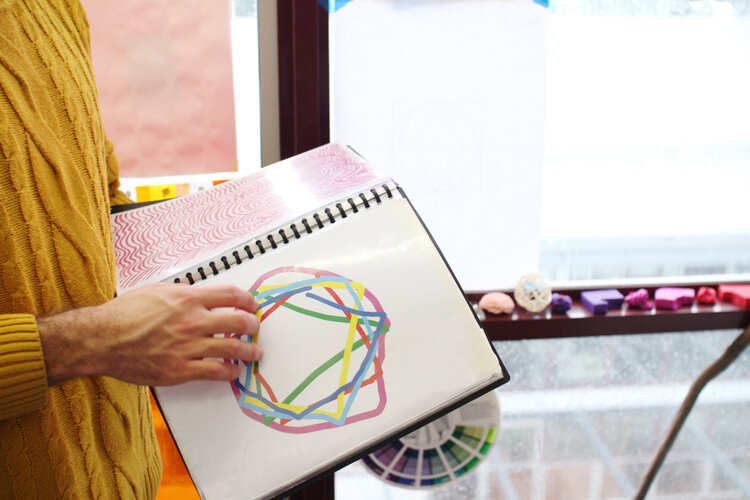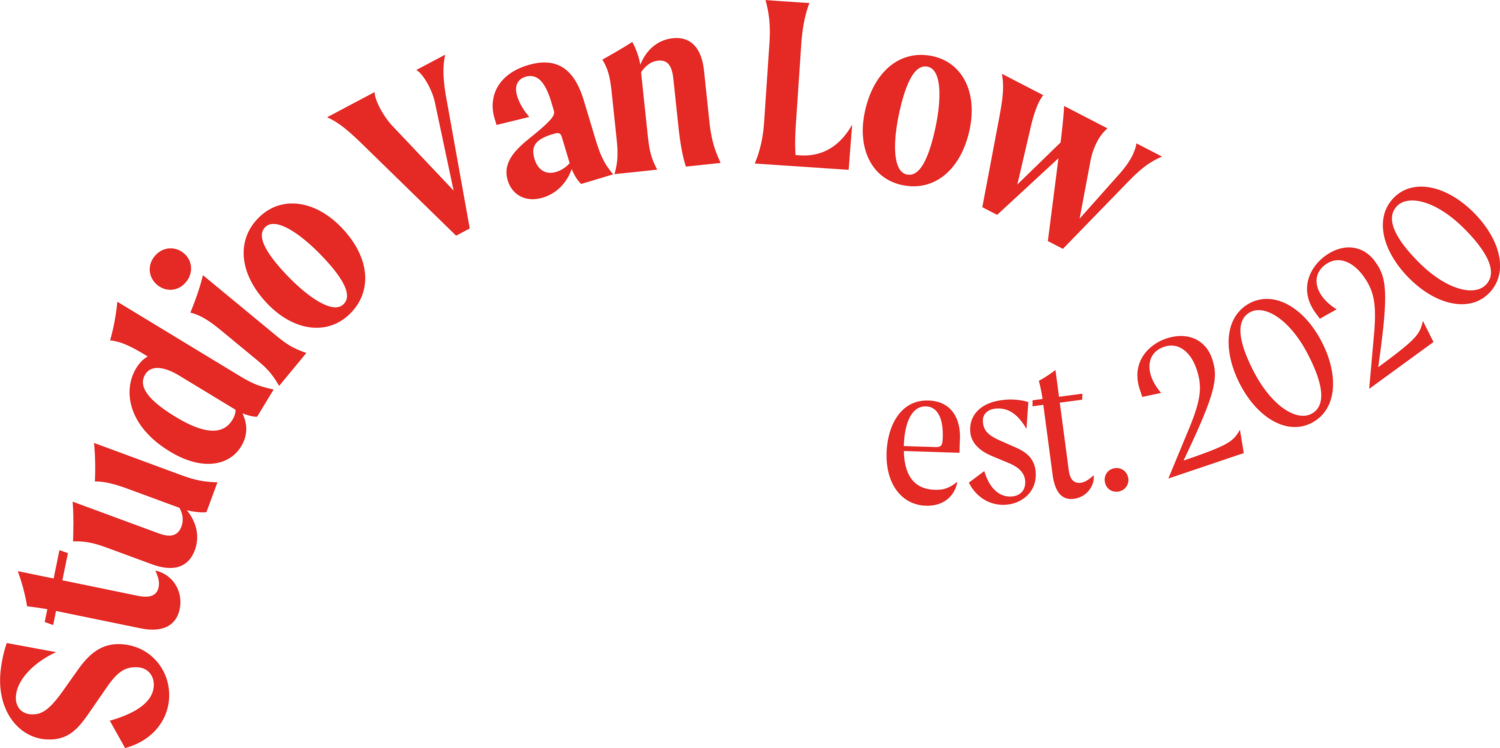Kieran Butler
Published on The Monday Issue, June 2014
Kieran Butler is an artist and fellow COFA honours student. Working within the field of post-photography, Kieran is currently investigating notions of vision by exploring the perception of colour.
Sculpture, installation, and video are also used in Kieran’s practice to create works that question the nature of the photographic medium at large, and its authority as a true representation of materiality. From afar, Kieran’s works appear as bright fields of colour, reminiscent of doodles or early computer graphics, however upon looking closer we can identify tensions between the physical objects and digital planes. Although Kieran is precise in his work, experimentation plays a key role in his process. I interviewed Kieran in his studio, where evidence of his multitudinous experiments lined the walls, to talk about magenta, his artistic process, and maintaining that standout moustache.
Vanessa Low: Fill in the blanks:
Kieran Butler: My name is (Kieran), I am (a visual artist), from (Sydney). My art practice involves (explorations of photography and questioning what the photographic can be. I expand my work beyond traditional photographic prints to installations, sculptural objects, and videos). I am an artist because (honestly, I can’t picture myself doing anything else).
VL: You’ve mentioned that you had not practiced photography before university; how did you develop an interest in the medium?
KB: I never actually studied photography until I came to university to study visual arts. And so, in first year, I thought my major would be painting and drawing because that’s what I love to do – but it’s more of a hobby than a big part of my practice now. I got to try photography at university for the first time and I just sort of fell in love with photography – it’s sort of magic.
VL: Have you always desired to be an artist? What’s informed your journey to this point?
KB: I always consider myself to be pretty lucky because I’ve always wanted to do something creative. I remember when I was younger I used to want to be an author or an illustrator. At one point I wanted to be an archaeologist, which is very linked to history, and history is very much a big part of art. When I started uni I studied a double degree majoring in history (Arts) and photography (Fine arts) but I though that there was something about it that just wasn’t clicking. Photography, like my practice, is very much based on my intuition; my instincts were telling me there was something about history that was just not working for me. I think I get enough of that in my practice as well, so I decided to focus on my fine arts and drop my history major.
VL: A book I can always reread is…
KB: I generally don’t reread books twice because there is so much out there to read. But the only one that I’ve read twice is The Hobbit. It’s really nerdy but it’s my favourite story; it’s just got everything in it.
VL: The nature of photography has evolved through many different conceptions over time – on one hand we have the photograph as an indexical truth, on another hand it questions the notion of vision itself. Can you describe some ideas that you’re currently exploring in your work, and what notion of photography you engage with?
KB: In general, my practice is about photography – the foundation I build all my work on is photography, and the question of what is photography. I was really enchanted learning about Walter Benjamin and his theory on the Optical Unconscious – I was fascinated by the idea of photography’s ability to show us parts of the world that we can’t see.
More specifically I’m working within the fields of post-photography and post-medium, and I like to question the materiality of things. I think photography is a perfect medium [to do so] because there is a lot of tension in its materiality.
VL: Can you tell us about your exploration of colour and magenta?
KB: I started exploring colour definitely last year in my work, but last year it was more focused on observation and vision, and the processes involved in that. I narrowed it down more this year to the processes involved in observations of colour – how we can conceptualise a colour and how we can perceive colour.
In particular, in the case of magenta I found that it’s just this weird colour that sits in between being concrete and ambivalent – it exists, but it doesn’t exist. A bit of background on the colour – magenta is an extra-spectral colour, so that means that in the rainbow with red at the start and violet at the end, we don’t actually see magenta because it’s not technically visible. It doesn’t have its own wavelength; it’s not a physical, tangible thing as such. But at the same time it is because we can see it. So, magenta is your brain filling in the blanks. Magenta is almost like a blank – it exists outside the spectrum of colour. It is what happens when you compose red and violet together, it terms of light.
VL: Favourite art spaces in Sydney?
KB: There’s so many great and different art spaces in Sydney. Without being biased, a couple are:
1) MOP Projects and Gallerie Pom Pom – not just because I volunteer there and have a lot to do with it, but I think it’s a really nice space. I think their model of an artist run initiative is very current, especially in its combination with a commercial space. I really like that idea.
2) Breezeblock – I recently had work in an exhibition there. The premise of breezeblock is that it’s in an office building and basically is the empty spaces that are for lease that are gallery spaces. It’s called Breezeblock because, without sounding cliché, it floats like a breeze in and out of these spaces as they become leased. Re-inhabiting the empty space that’s not being used and giving it a life. I really like the idea behind that space too.
VL: Can you describe your process artistic process? Do you do a lot of planning or experimentation?
KB: I always like to think that I plan, but I don’t. It’s all experimentation. So, this year in particular, I’ve really become aware of the fact that I work a lot on experimentation and that intuitive process of observation and using my gut instincts to direct me in what I’m doing. I don’t necessarily have a really good idea of what my work will look like but I have an idea of how I want to go about it. I go about it and see what happens, because it’s not entirely predictable.
VL: You’ve mentioned your use of large format film, and post-production. Could you explain this part of your process?
KB: Normally I start off with an idea with my digital camera because these days, unfortunately, large-format and medium-format film has become quite a niche specialist kind of thing and is really hard to come by. They recently discontinued my favourite kind of film, so I’ve had to adjust how I work with colour this year because the colour in film is very different and unpredictable. So I’ll start off with digital to visualise what I’m doing and to get a better sense of feeling for the work that I’m attempting to make.
Once I’ve done the digital, it gives me all the settings that I apply to film. I do my film all in one go. With digital, I’ll have lots and lots of different shots and angles, then with the film I’ll probably have four completely finished ones that I don’t have to bracket or re-do because I’ve done all the experimentation beforehand.
Then post-production – I can’t do any of the processing myself as unfortunately I haven’t learnt how to do colour processing; my next step is to learn that. I get it developed at a lab, and then I scan the film in using a hi-res scanner. Then once it’s in the computer, I’ll use Photoshop. This is what I’m doing with my current work. I’m photographing these constructions in the studio and then adding them into Photoshop, so they sit somewhere in between real and unreal – building on that tension in photography. Sometimes it might end up being rephotographed, or I might even film it. I don’t know how I’ll produce it once it’s gone through a computer the second time.
VL: How do you maintain your stylish moustache?
KB: Every morning I have to wash it with warm water, which makes it softer and easier to put the wax through. A question I get asked a lot about the wax is if it’s hair wax, which it’s definitely not. It’s moustache wax, which is very tough and firm so that it maintains its shape. My moustache definitely needs a firm wax because it’s messy. The wax I get is from Mississippi, made by a fireman who wanted to maintain his moustache during work – or so his sales pitch goes. Firehouse Moustache Wax, called Wacky Tacky.
VL: Do you draw any inspiration from any particular artist or art movement?
KB: I love the work of James Turrell – I found that this year, researching his practice has helped me understand my practice. Even though his work is different in many ways from mine, in the sense that it is such large scale and it’s architecture; it’s environment; it’s use of the land and sky. But in terms of observation in colour, it’s almost the same thing that I’m talking about.
Also, I’m interested in photographic artists in general, especially Thomas Demand, and painters including Mark Rothko and Joseph Albers. Lately I’ve found three really upcoming artists – Jessica Eaton, who makes colour field photographs all done with large-format film. Artie Vierkant and Lucas Blalock, both from New York, who work a lot with post-internet, Photoshop, and the still life.
VL: Something that I’m looking forward to is:
KB: I’m going to the Hunter Vallery tomorrow morning, so that’s exciting. But I’m also really looking forward to the holidays/semi-break where we have to do work. I’m Looking forward to that because it will be 5 – 6 weeks where I can spend time in my own head without too many people, which is one thing I found that I’m struggling with a little bit, this having too much input, too much information, about my work. Generally looking forward to the end of the year, the Annual [exhibition], and seeing what my project turns out like this year and seeing how my research goes.
-
www.kieranbutler.net
Words & photography by Vanessa Low











